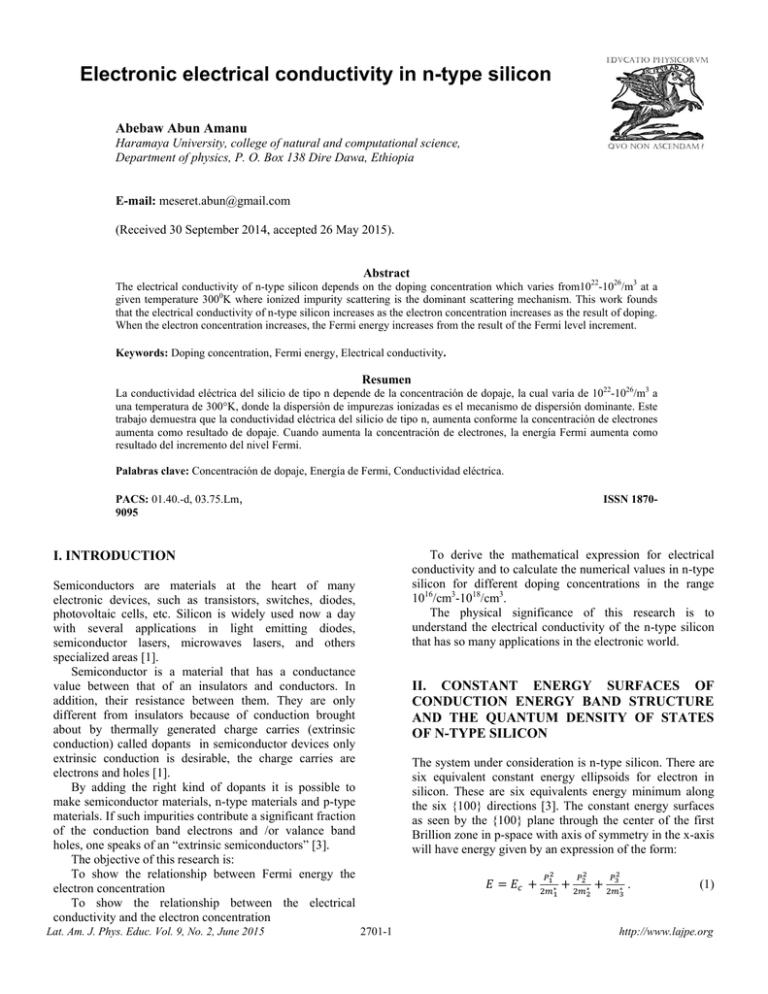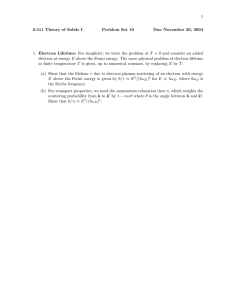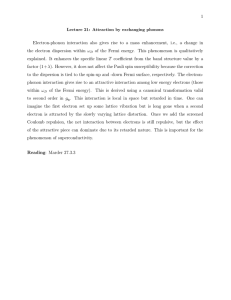Electronic electrical conductivity in n
advertisement

Electronic electrical conductivity in n-type silicon
Abebaw Abun Amanu
Haramaya University, college of natural and computational science,
Department of physics, P. O. Box 138 Dire Dawa, Ethiopia
E-mail: meseret.abun@gmail.com
(Received 30 September 2014, accepted 26 May 2015).
Abstract
The electrical conductivity of n-type silicon depends on the doping concentration which varies from1022-1026/m3 at a
given temperature 3000K where ionized impurity scattering is the dominant scattering mechanism. This work founds
that the electrical conductivity of n-type silicon increases as the electron concentration increases as the result of doping.
When the electron concentration increases, the Fermi energy increases from the result of the Fermi level increment.
Keywords: Doping concentration, Fermi energy, Electrical conductivity.
Resumen
La conductividad eléctrica del silicio de tipo n depende de la concentración de dopaje, la cual varía de 1022-1026/m3 a
una temperatura de 300°K, donde la dispersión de impurezas ionizadas es el mecanismo de dispersión dominante. Este
trabajo demuestra que la conductividad eléctrica del silicio de tipo n, aumenta conforme la concentración de electrones
aumenta como resultado de dopaje. Cuando aumenta la concentración de electrones, la energía Fermi aumenta como
resultado del incremento del nivel Fermi.
Palabras clave: Concentración de dopaje, Energía de Fermi, Conductividad eléctrica.
PACS: 01.40.-d, 03.75.Lm,
9095
ISSN 1870-
To derive the mathematical expression for electrical
conductivity and to calculate the numerical values in n-type
silicon for different doping concentrations in the range
1016/cm3-1018/cm3.
The physical significance of this research is to
understand the electrical conductivity of the n-type silicon
that has so many applications in the electronic world.
I. INTRODUCTION
Semiconductors are materials at the heart of many
electronic devices, such as transistors, switches, diodes,
photovoltaic cells, etc. Silicon is widely used now a day
with several applications in light emitting diodes,
semiconductor lasers, microwaves lasers, and others
specialized areas [1].
Semiconductor is a material that has a conductance
value between that of an insulators and conductors. In
addition, their resistance between them. They are only
different from insulators because of conduction brought
about by thermally generated charge carries (extrinsic
conduction) called dopants in semiconductor devices only
extrinsic conduction is desirable, the charge carries are
electrons and holes [1].
By adding the right kind of dopants it is possible to
make semiconductor materials, n-type materials and p-type
materials. If such impurities contribute a significant fraction
of the conduction band electrons and /or valance band
holes, one speaks of an “extrinsic semiconductors” [3].
The objective of this research is:
To show the relationship between Fermi energy the
electron concentration
To show the relationship between the electrical
conductivity and the electron concentration
Lat. Am. J. Phys. Educ. Vol. 9, No. 2, June 2015
II. CONSTANT ENERGY SURFACES OF
CONDUCTION ENERGY BAND STRUCTURE
AND THE QUANTUM DENSITY OF STATES
OF N-TYPE SILICON
The system under consideration is n-type silicon. There are
six equivalent constant energy ellipsoids for electron in
silicon. These are six equivalents energy minimum along
the six {100} directions [3]. The constant energy surfaces
as seen by the {100} plane through the center of the first
Brillion zone in p-space with axis of symmetry in the x-axis
will have energy given by an expression of the form:
.
2701-1
(1)
http://www.lajpe.org
Abebaw Abun Amanu
Where m1*=ml=0.92m0 is the longitudinal effective mass
and m2*=m3*=mT=0.91m0 is the transverse effective mass.
By adding appropriate transformation to anew P’ coordinate
system in which the constant energy surface because
spherical. The energy can be expressed in the form:
.
.
In addition, the normalized electron concentration
(8)
is:
.
(2)
(9)
We assume that the total mobile electron concentration in
the conduction band is equal to donor concentration Nd that
varies from 1022-1026/m3 in our calculation.
Where
is the density of the states
effective mass and Mv=6 number of equivalent energy
valleys. The number of quantum states in P-space in the
energy range E+dE is:
IV. BOLTZMANN TRANSPORT EQUATIONS
.
(3)
The conductivity of a substance is determined by the
concentration and mobility of charge carriers. The
probability of electrons occupying a unit volume of phase
space with the center at point(x, k) at the moment of time t
is
That is to say
is the distribution
function for no equilibrium state the distribution function
will change with time, the nature of change being
dependent on which process predominates; the change due
to the action of the electric field (F), and as a result of
charge carrier collision(C).
If we measure energy from the bottom of conduction Ec=0,
then
can be expressed as:
.
(4)
III. FERMI DIRAC STATISTICS FOR N-TYPE
SILICON
.
The number of states per unit volume between
and
in allowed band
can be calculated from
the volume between and
in an allowed band,
can be calculated from the volume between and
in kspace divided by the volume of a single state in k-space. If
the shape of the energy surface in the k-space is known for
a given material, therefore,
can be calculated. If
is the probability that a state with energy will be
occupied states is given by an expression of the form:
.
(10)
Where:
.
(11)
.
(12)
Or
(5)
=
Where is the number of electrons in the conduction band,
now the function
, the profanity that a state with energy
will be occupied, is just the Fermi distribution function.
For electron occupation of the conduction band,
can be expressed as:
.
.
(13)
For the present, we want to avoid excessive complications
by means of relaxation time approximations for
. The
effect of collisions is always to restore a local equilibrium
situation described by the distribution function
.
Let us further assume that if the electron distribution is
distributed from the local equilibrium value , then the
effect of the collision is simply to restore to the local
equilibrium value exponentially with a relaxation time τ
which is the order of the time between electron collisions
with ion, i.e.:
(6)
Where is the Fermi energy:
To derive the number of electrons in the conduction
band, use the above equations. Substitute Eq. (4) and Eq.
(6) into Eq. (5), i.e.
.
.
(7)
From the relations:
.
Lat. Am. J. Phys. Educ. Vol. 9, No. 2, June 2015
(14)
2701-2
(15)
http://www.lajpe.org
Electronic electrical conductivity in n-type silicon
Is the Rutherford scattering cross-section and v is the
relative velocity between electron and ion and can be taken
as electron velocity.
The Conwell and Weisskopf formula for ionized
impurity relaxation time is:
Substitute Eq. (3.6) into Eq. (3.5):
.
(16)
Where
is the effective mass of an electron.
From the general relation of the electrical force and the
electric field, we get the below equation.
Where e=1.6x10-19C, electric charge and Ex is the
electric field in the x-direction.
.
.
Where ε is the dimensionless kinetic energy. Among varies
scattering mechanisms responsible for resistivity in the
temperature range 77-3000K and for electron
concentration,
the ionized impurity scattering
is the dominant scattering mechanism. We shall use the
above expression of relaxation time for ionized impurity
scattering in subsequent sections to obtain the explicit
expression for thermal conductivity.
(17)
For the steady state condition, the electron distribution is
independent of time, i.e.
, Eq. (17) becomes:
.
(23)
(18)
VI. ELECTRICAL CONDUCTIVITY
Where in the relaxation time approximation:
.
Electrical conduction is transport processes resulting from
the motion of charge carriers under the action of internal or
external field. Conductivity of n-type silicon in which the
conductivity is due to the excess electrons. Current is
defined as the time rate at which charge is transported
across a given surface in a direction normal to it, the current
will depend on both number of charges free to move and
the speeds at which they move. Electrical conduction takes
place as a result of the motion of the free electrons under
the action of an applied electric field [6].
(19)
And
.
(20)
V. ELECTRON SCATTERING MECHANISM
There are different scattering mechanisms like acoustic
phonon scattering, ionized impurity scattering, carriercarrier scattering among others responsible for the
resistivity of the material. Conwell and Weisskopf have
calculated the rate of change of distribution function due to
ionized impurity scattering by using the following
assumptions:
i. In the electron ionized impurity scattering only the
direction of electrons changes
ii. An electron gets scattered by a single ion at a time i.
e. by the one which is closest to it at that particular
instant of time.
Therefore one can express the number of electrons per
unit volume per second into a solid angle
at , as:
.
VII.
DERIVATION
CONDUCTIVITY
OF
ELECTRICAL
Current is defined as the time rate at which charge is
transported across a given surface in a direction normal to
it, the current will depend on both the number of charges
free to move and the speeds at which they move.
The electrical current density is given by:
.
.
(24)
(25)
Where can be expanded as
to the first
order approximation for weak/normal dc electric field.
(21)
Where
is the number of electron per unit volume.
is the number of electrons per unit volume
with solid angle
.
.
.
(26)
, since no current flows in equilibrium,
does not contribute to the electric field current. Thus:
(22)
.
Lat. Am. J. Phys. Educ. Vol. 9, No. 2, June 2015
2701-3
(27)
http://www.lajpe.org
Abebaw Abun Amanu
The Boltzmann transport equation in the presence of a d. c
electric field
in the x direction is calculated by:
.
.
(28)
Using integration by substitution, we can integrate the
above equation, i.e. let
, then –
.
Replacing the first thing in u, then:
, leaving the higher order terms in the expansion
of . From the above Eq. (28) relations:
i.e.
.
.
(29)
Then:
Then:
.
.
(30)
(39)
Substitute Eq. (23) into Eq. (39), then:
Thus:
.
.
(31)
(40)
From the relation of v and energy E:
By using solid angle relations:
.
(32)
.
(41)
Substitute this Eq. (32) into Eq. (30):
.
(33)
(42)
Substitute Eq. (42) into Eq. (40):
.
(43)
(44)
(34)
From the vector v and angle
Substitute Eq. (44) into Eq. (43):
relations:
(35)
.
(45)
Substitute Eq. (35) into Eq. (34):
.
(46)
Change all the energies that are the equation becomes
dimensionless kinetic energy of an electron.
.
(36)
.
By using the relations of the above equations, we can drive
the below equation.
(47)
Substitute Eq. (47) into Eq. (46):
(37)
(48)
.
(49)
(38)
Lat. Am. J. Phys. Educ. Vol. 9, No. 2, June 2015
2701-4
http://www.lajpe.org
Electronic electrical conductivity in n-type silicon
.
(50)
By using integration by parts we can solve the above
complex mathematical equation. So:
.
(61)
This Eq. (61) is known as the normalized electrical
conductivity.
(51)
VIII.
NUMERICAL
CALCULATION
ELECTRICAL CONDUCTIVITY
OF
(52)
To calculate numerical values of the normalized Fermi
energy
and the dimensionless electrical conductivity
for the given electron concentration, use the formula for
electron concentration.
. (62)
By substituting:
Where
.
Whit
(53)
Finally:
is the dimensionless
kinetic energy.
. (54)
.
(63)
.
(64)
. (55)
From the general relation of
.
By substituting the numerical values of the constants, will
got:
(56)
.
(57)
.
(65)
. (58)
This integral is known as Fermi integral.
To get the dimensionless Fermi energy using the given
value of normalized electron concentration those are shown
in Table I.
Using Equation (9) for normalized doping concentration
and the integral Equation (64). The integral Equation
(64) for electron concentration is difficult to evaluate
because the normalized Fermi energy
is unknown.
By using iteration method in such a way that for a given
arbitrary value of
the left side of the integral Equation
(64) can be evaluated by using a Mathematica 5.1 software
program. The value of the normalized electron
concentration obtained by this numerical calculation will be
compared with the known initial value
=0.04628. I
Substitute Eq. (8) into Eq. (58), i.e.:
.
.
Lat. Am. J. Phys. Educ. Vol. 9, No. 2, June 2015
(59)
(60)
2701-5
http://www.lajpe.org
Abebaw Abun Amanu
continue my calculation until I get the precise value of the
normalized Fermi energy
corresponding to the given
normalized electron concentration =0.04626.
Therefore, I get the value on the right side of Eq. (64)
which must be approximately equals to the value of
on
the left side of Eq. (64) with an error in the order of 10-3.
This iteration method is used again to get the other values
of the normalized Fermi energy
corresponding to the
given electron concentration
in the table. These values
are used to calculate dimensionless electrical conductivity
corresponding to the given value of the normalized
electron concentration
as shown in the below table.
When we see the first graph, the normalized Fermi
energy increases as the doping concentration or the
normalized electron concentration nn increases.
When we increase the normalized electron
concentration, by doping it from time to time, the Fermi
energy level increases with it.
We get negative Fermi energy when the location of the
Fermi level is below the bottom of the conduction band and
a positive Fermi energy when the location of the Fermi
level is above the bottom of the conduction band.
TABLE I.
Normalized electron
concentration (nn)
Dimensionless
Fermi energy
Normalized electrical conductivity
0.0462845
-4.23354
4.528399
0.12039
-3.26945
4.55227
0.1605
-2.97748
4.565182
0.240398
-2.56469
4.590962
0.5095
-1.80185
4.675266
0.750925
-1.36966
4.756477
1.0009
-1.05497
4.837995
1.50085
-0.59533
5.002002
2.0008
-0.25354
5.167141
2.50075
3.0007
3.50065
4.0006
0.023557
0.259635
0.46734
0.65422
5.333409
5.500866
5.669359
5.838826
4.50055
0.825143
6.009266
5.0005
0.983438
6.180707
5.50045
1.131475
6.352981
6.0004
1.27101
6.526144
6.50035
1.403375
6.700136
7.0003
7.50025
8.0002
8.50015
9.0001
9.50005
10
1.529607
1.65025
1.766795
1.878955
1.987462
2.092687
2.19496
6.874981
7.050141
7.226896
7.407064
7.581702
7.760182
7.939213
Normalized electron concentration
FIGURE 1. Dimensionless Fermi energy vs. normalized electron
concentration.
10
8
6
4
2
0
0
5
10
15
Normalized electron concentration
FIGURE 2. Normalized electrical conductivity vs. normalized
electron concentration.
IX. ANALYSIS AND DISCUSSION ON THE
RESULT
The graph of normalized electrical conductivity ( ) vs.
normalized electron concentration nn shows that the
electrical conductivity of the semiconductor increases by
increasing the electron concentration in the conduction
band as a result of doping.
The numerical values are used to draw the graph of
normalized Fermi energy
vs. normalized electron
concentration nn.
Again, the numerical values are used to draw the graph
of dimensionless electrical conductivity ( ) vs. normalized
electron concentration nn.
Lat. Am. J. Phys. Educ. Vol. 9, No. 2, June 2015
2701-6
http://www.lajpe.org
Electronic electrical conductivity in n-type silicon
X. CONCLUSION
REFERENCES
In this research, investigation of how the electrical
conductivity of n-type silicon depends on the doping
concentration which varies from 1022-1026/m3 at a given
temperature 3000K where ionized impurity scattering is the
dominant scattering mechanism.
The paper found that the electrical conductivity of ntype silicon increases as the electron concentration
increases, the Fermi energy increases from the result of the
Fermi level increases.
[1] Warnes, L., Electronic and electrical engineering:
Principles and practice, (Palgrave Macmillan, New York,
1995.
[2] Maheshwari, L. K. & Anand, M. M. S., Laboratory
manual for introductory electronic experiments, (New Age
International, New Delhi, 2000).
[3] Ascfroft, N. W. & Mermin, D., Solid state physics,
(Brooks Cole, Boston, 1976).
[4] Floyd, T. L. & Buchla, D. M., Electronics
fundamentals: Circuits, devices & applications, 4th Ed.
(Pearson education limited, Harlow, 1998).
[5] Reif, F., Foundamental of statistical and thermal
physics, (Mac Graw Hills, Boston, 1985).
[6] Adler, R. B., Smith, A. C. & Longini, R. L.,
Introduction to semiconductor physics, (John Wiley &
Sons, New York, 1964).
Lat. Am. J. Phys. Educ. Vol. 9, No. 2, June 2015
2701-7
http://www.lajpe.org



